Beehiiv vs Ghost at a glance (2025)
What you’ll learn
A quick side‑by‑side of Beehiiv and Ghost for newsletters and publishing
Who each platform is really for in 2025
Clear guidance on growth, monetization, customization, pricing, and migration
A fast recommendation based on your goals
One‑sentence takeaway
Beehiiv: built by newsletter people for newsletter growth.
Ghost: a full publishing platform for building an owned media brand.
Note for readers exploring all‑in‑one blog + newsletter + AI automation
If you’re also considering a blog-first stack that includes integrated newsletters and heavy AI automation for SEO and content ops, keep BlogBowl in mind as a third path (we’ll explain in the verdict).
Feature | Beehiiv | Ghost |
|---|---|---|
Best for | Newsletter growth and monetization | Full publishing + memberships for an owned media brand |
Free option | Free plan up to 2,500 subscribers | Open‑source self‑hosting (free) or hosted trial |
Editor | Visual newsletter + block editor | Markdown + rich cards, editor built for long‑form publishing |
Growth toolkit | Referrals, Boosts, Ad Network, recommendations, magic links, automations | Native email + member tiers, tags, API/integrations (less growth gamification) |
Monetization | Paid subscriptions, Ad Network, sponsorship tools, boosts | Paid memberships via Stripe, tiers, free/paid posts, 0% platform fees |
Customization | No‑code website builder and clean templates | Full CMS themes, custom code, open‑source extensibility |
SEO | Solid SEO fundamentals | Strong technical SEO out of the box (sitemaps, canonicals, clean markup) |
Pricing model | Flat‑rate tiers by subscriber count | Tiered plans by member count (or run self‑hosted) |
Data ownership | You own and can export your subscriber list | You own content, members, and stack; open‑source option |
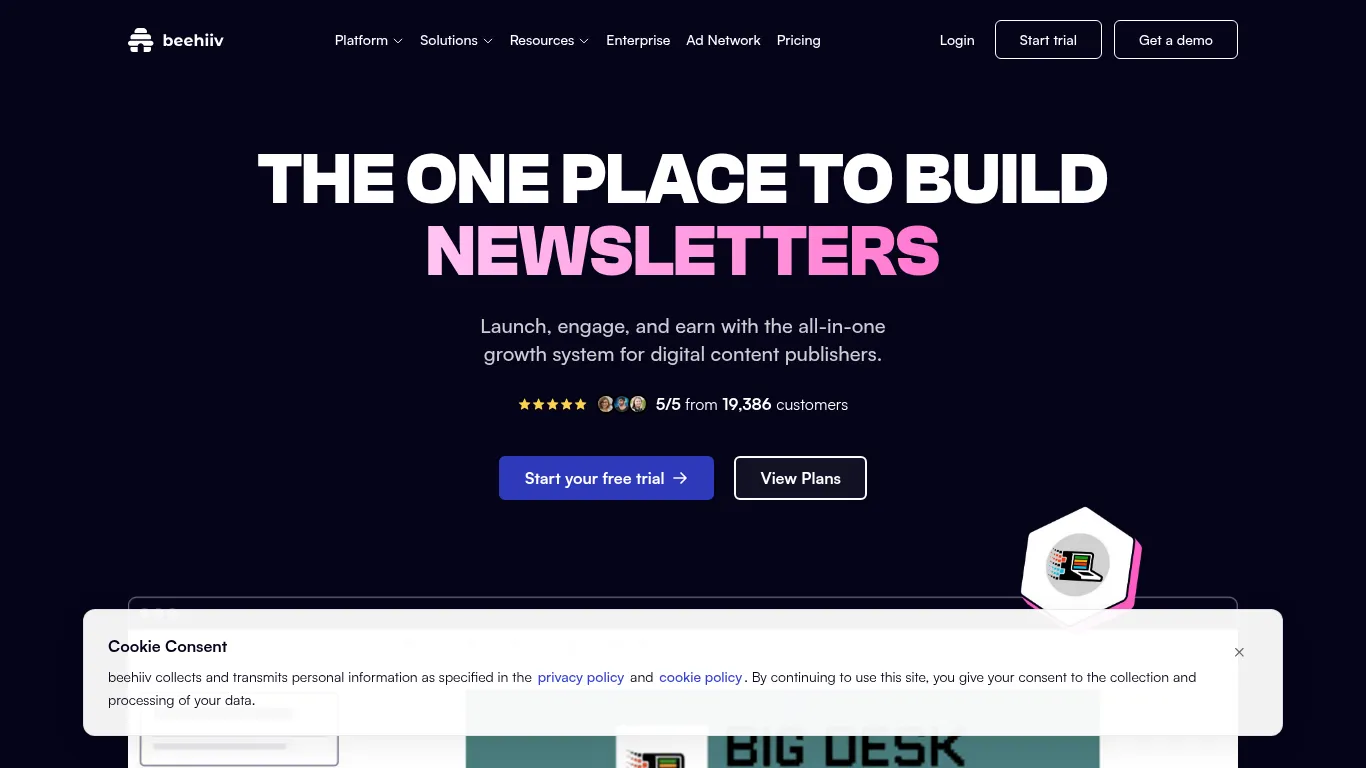
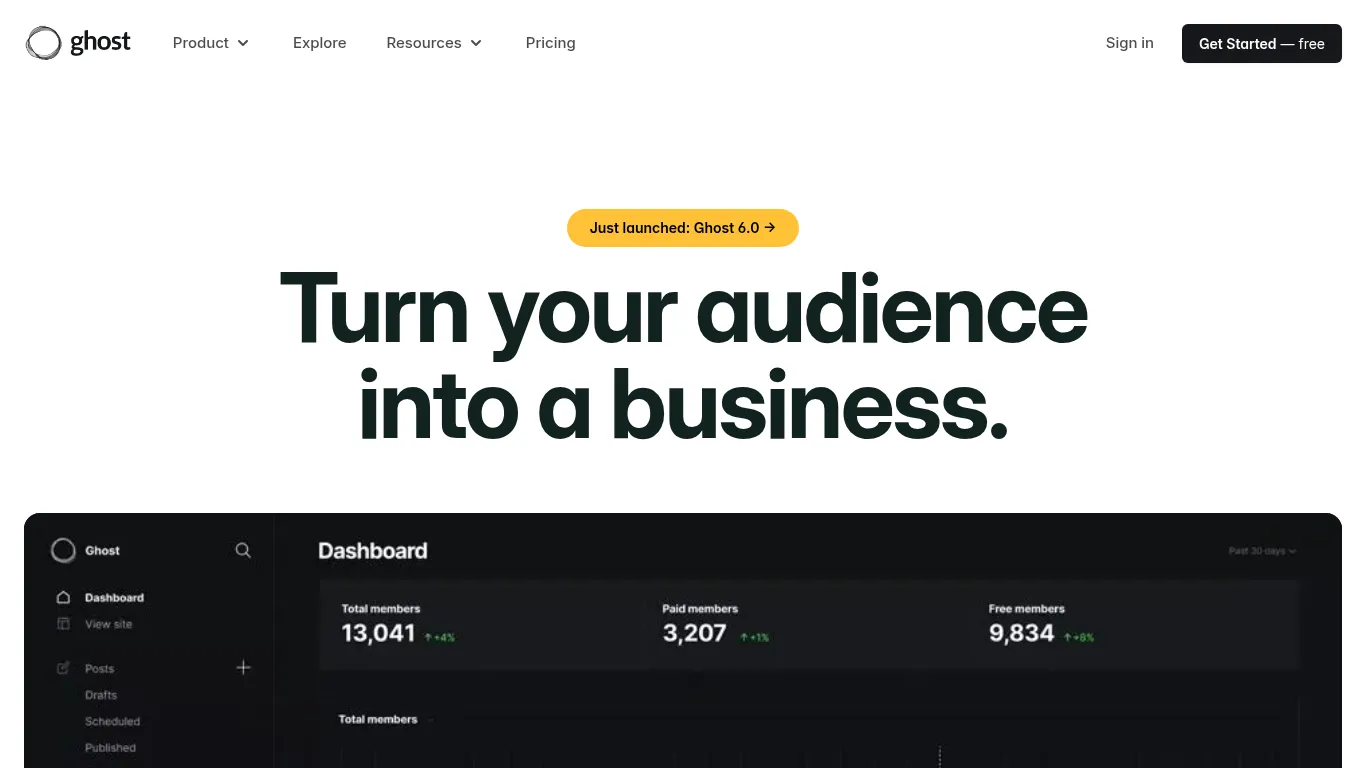
Who they’re for: platform philosophy and ownership
Core intent
Beehiiv: newsletter growth engine (referrals, boosts, ad network)
Ghost: open, independent publishing (blog + newsletter + memberships)
Hosting & control
Beehiiv: fully hosted, simple setup, quick to send
Ghost: two routes - Ghost(Pro) hosted or self‑host open‑source
Ownership & sustainability
Data export, domain control, and portability
Ghost’s non‑profit/open‑source ethos for long‑term independence
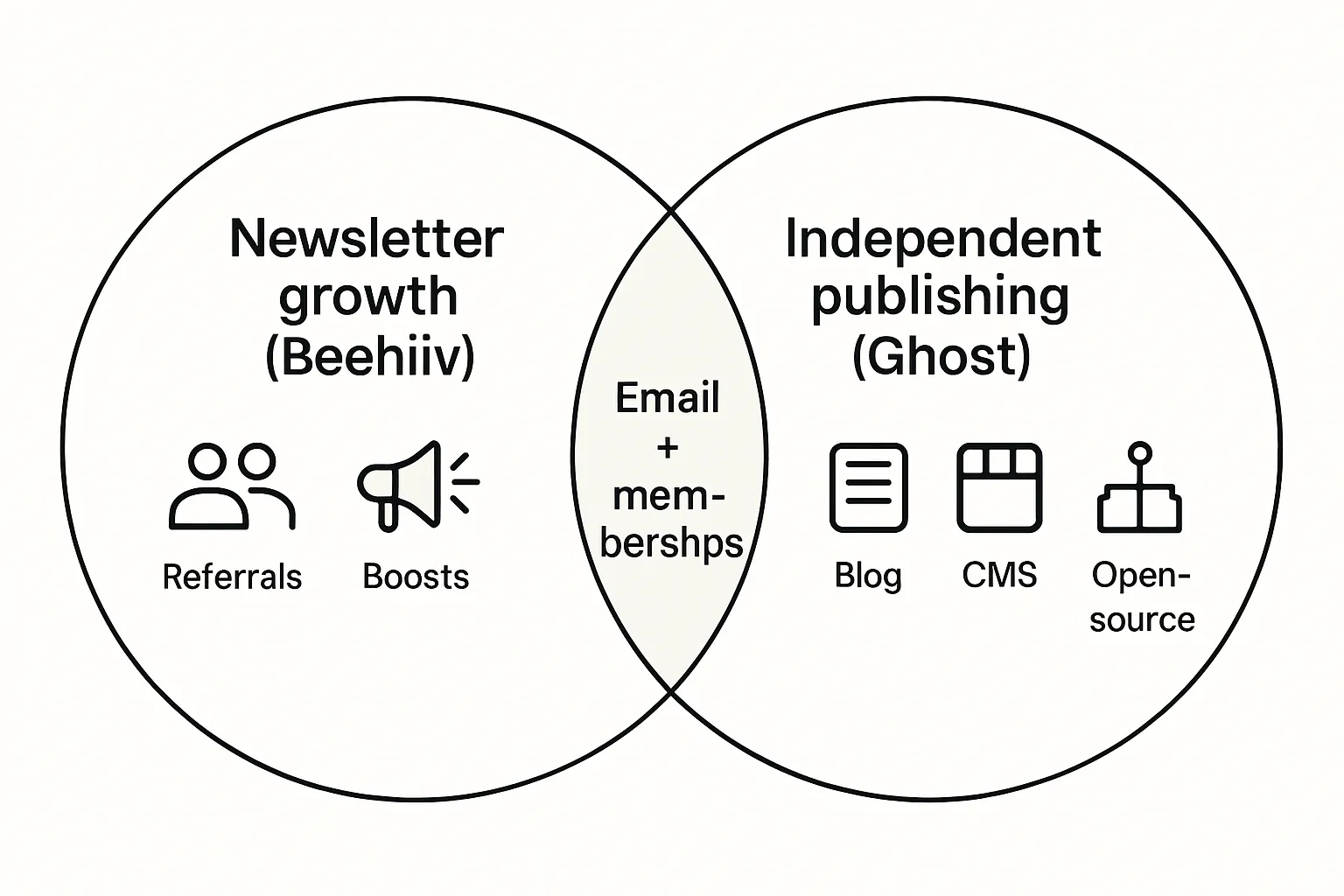
"Ghost is an open-source publishing platform maintained by the Ghost Foundation, a non-profit; all revenue is reinvested into the product and community." - Source
When each shines
Creator-led newsletter businesses vs. multi-format publications with deeper brand and site needs
Writing and publishing experience
Editor UX
Beehiiv: A clean, visual email editor with drag‑and‑drop blocks, polls, and simple templates makes it fast to assemble issues. It’s purpose‑built for newsletters, so layout decisions are quick and consistent. Formatting, embeds, and basic styling are intuitive, keeping you focused on the message rather than the mechanics.
Ghost: An elegant editor that combines Markdown with rich cards for embeds, galleries, bookmarks, and code. It shines for long‑form posts and multimedia, giving you fine control over structure and presentation. If your content skews toward essays, tutorials, or polished feature pieces, Ghost’s experience feels tailor‑made.
Content model
Beehiiv: Primarily a newsletter tool that also publishes issues as web posts automatically. This works well for creators who want every send to double as an online archive without extra steps.
Ghost: A full CMS with posts, pages, tags, collections, and members‑only areas. You can separate public vs. premium content, build topic hubs, and structure a publication that scales beyond a single newsletter feed.
Collaboration & workflow
Both platforms support multi‑author workflows, drafts, and scheduling. Beehiiv keeps things lightweight so teams can ship newsletters fast; Ghost offers more CMS‑like control when you need editorial structure across posts and pages.
Reusability is strong on both sides: templates and blocks in Beehiiv speed up production; Ghost’s reusable snippets, themes, and structured tagging support repeatable editorial patterns.
Internationalization basics are achievable on each, but Ghost’s CMS orientation generally makes organizing multilingual or regionalized content easier at scale.
Mobile & on-the-go
Beehiiv’s mobile editing is handy for quick fixes, last‑minute changes, or building simple sends on the move - useful when your cadence is frequent and time‑sensitive.
Ghost focuses on a desktop‑first writing flow that favors deep work and precise editing, ideal for longer articles, evergreen libraries, and multi‑asset posts that benefit from larger‑screen craftsmanship.
In short: if rapid newsletter production is your core workflow, Beehiiv’s editor and publishing flow keep you shipping. If you’re building a publication with long‑form articles, archives, and members‑only content, Ghost’s editor and CMS model give you room to grow.
Audience growth and deliverability
"Email marketing returns an average of about $36 for every $1 spent." - Source
Growth toolkit
Beehiiv: Purpose-built growth features like referrals, recommendations, magic links, boosts, and a partner/ad network help you compound subscriber growth directly inside the platform. These tools reduce dependency on external promos and speed up list velocity.
Ghost: Growth leans on strong organic discovery via SEO, flexible integrations, and community-led promotion (social embeds, cross-posting, and partnerships). It’s ideal when your publication plays a long game across search and owned channels.
List-building & capture
Both support embedded forms, landing pages, and popups for capture. Prioritize double opt-in for cleaner lists and better inbox placement, and place CTAs across your site (nav, article inline blocks, exit-intent modals). Use UTM tagging to identify high-converting sources and refine where you invest.
Deliverability factors
Infrastructure and authentication: Set up SPF, DKIM, and DMARC, warm new sending domains, and maintain healthy suppression lists (bounces, complaints, long-time inactives).
Content cadence and consistency: Send on predictable schedules and avoid sudden volume spikes to preserve sender reputation.
Testing:
Beehiiv: Built-in A/B testing for subject lines and content blocks gives an edge in optimizing opens/clicks.
Ghost: Simpler send options - deliverability relies more on consistent list hygiene, authentication, and content quality.
Managing churn & engagement
Segmenting by behavior (opens, clicks, recency) and interest tags helps you personalize content and reduce unsubscribes.
Use polls/surveys to gather reader intent; feed insights into content plans and onboarding sequences.
Re-engagement flows: Win back inactive subscribers with a short sequence and remove non-responders to protect deliverability.
Send-time optimization: Test weekday vs. weekend and morning vs. afternoon in small cohorts; scale what works to protect engagement rates and sender reputation.
Monetization: how each platform helps you earn
Beehiiv revenue paths
Ad Network (sponsorship marketplace) for turnkey placements that match your audience
Paid subscriptions for premium issues and bonus content
Direct sponsorships managed in‑house with custom packages
Boosts/paid recommendations to earn per subscriber referred
Ghost revenue paths
Membership tiers (monthly/annual) with metered or fully gated content
Paid newsletters for members only
Premium posts and series with granular access control
Coupons, trials, and discounts to optimize conversion
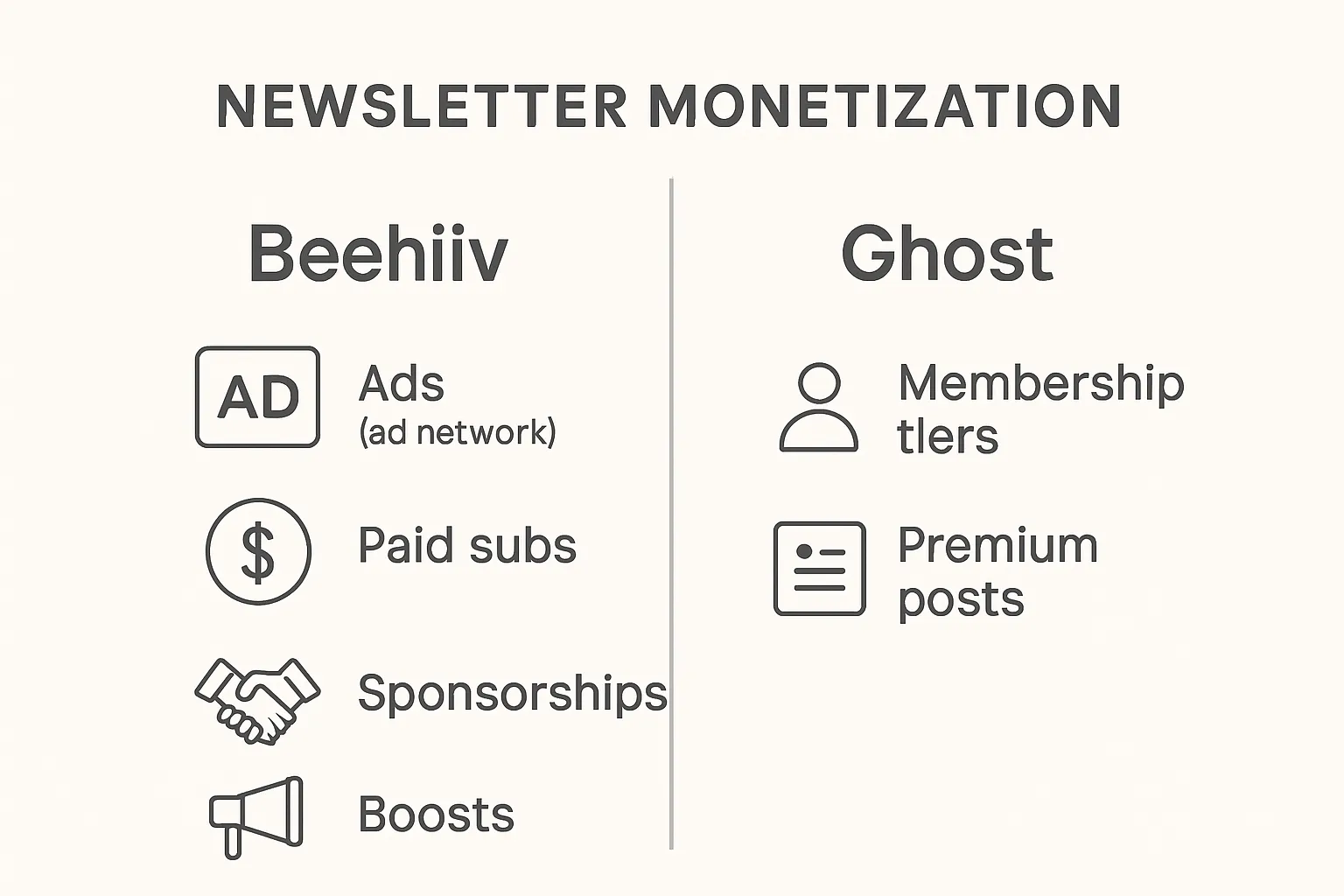
Fees & payouts
Platform fees: 0% on paid subscriptions for both; monetization primarily routes through Stripe.
Processor fees: Expect standard Stripe rates per transaction; factor currency and cross‑border costs if relevant.
Payout cadence: Configure in Stripe; aim for predictable schedules to manage cash flow.
Taxes & VAT: Use Stripe Tax or a similar solution to collect/remit where required; clearly communicate pricing and tax handling to members and sponsors.
Matching model to audience
Starting paid tiers: Introduce when you have consistent cadence, clear value, and ≥1–3 flagship content pillars your audience will pay for.
Sourcing sponsors: Build a media kit, define ICP/verticals, and test blended pricing (flat + performance). Beehiiv’s network can supplement direct outreach.
Balancing free vs. premium: Keep top‑of‑funnel free content discoverable; reserve depth, timeliness, or tools/templates for paid. Iterate with surveys and track conversion drivers to refine your mix.
Pricing, scaling, and total cost of ownership
Free-to-start differences
Beehiiv offers a free plan with a subscriber cap, making it easy to validate your idea while building initial momentum.
Ghost provides a free, open-source self‑host path; hosted plans start with a trial. Self‑hosting trades lower software costs for more technical responsibility.
Hosted plans in practice
Out of the box, both hosted experiences cover sending, hosting, templates/themes, and support. Beehiiv centers on newsletter tooling and built‑in growth features; Ghost(Pro) packages a full CMS for long‑form content, site structure, and memberships.
At early, growth, and pro stages, Beehiiv’s tiers scale around subscribers and growth features; Ghost(Pro) scales around members and publication features, with the option to move to self‑host if you want deeper control.
Total cost of ownership
Factor email volume, team seats, and integration needs. Beehiiv keeps complexity low with integrated growth and monetization; Ghost can incur custom dev/design costs if you want bespoke themes or workflows.
Self‑hosting Ghost adds server costs, updates, backups, security, and general maintenance - versus the simplicity of fully hosted plans.
Scenario snapshots (qualitative)
Solo writer launching from zero: Beehiiv’s free plan removes friction; Ghost’s self‑host is great if you’re comfortable with setup.
Newsletter at 10–25k subscribers: Beehiiv’s native growth/monetization accelerators reduce tool sprawl; Ghost scales cleanly for publications investing in SEO, archives, and memberships.
Publication with multi-author CMS + memberships: Ghost’s CMS depth and open architecture favor long‑term brand control; Beehiiv excels if the newsletter is the primary product and growth is the priority.
Feature | Beehiiv | Ghost |
|---|---|---|
Free plan availability | Yes (subscriber cap) | Self‑host free (open‑source); hosted trial available |
Hosted option | Yes | Yes (Ghost(Pro)) |
Self-host option | No | Yes (open‑source) |
0% platform fee | Yes (subscriptions) | Yes (memberships) |
Referral tools | Native referrals/recommendations | Not native; achievable via integrations/custom |
Ad network | Built‑in sponsorship marketplace | Not included |
A/B testing | Native for subject/content | Not native |
Theme marketplace | Limited (site builder focus) | Robust marketplace and custom themes |
API | Yes | Yes |
Concierge/migration support | Standard import tools | Concierge available on select plans |
Notes | “Always confirm latest pricing on official pages.” | “Always confirm latest pricing on official pages.” |
Customization, SEO, and integrations
Design flexibility
Beehiiv: Modern templates and an evolving website builder make it easy to launch a branded presence quickly. Great for creators who prioritize speed and consistency without heavy code.
Ghost: A full themes marketplace, code injection, and template control (Handlebars) enable deep customization. Ideal for publishers who want unique layouts, advanced components, and a bespoke brand system.
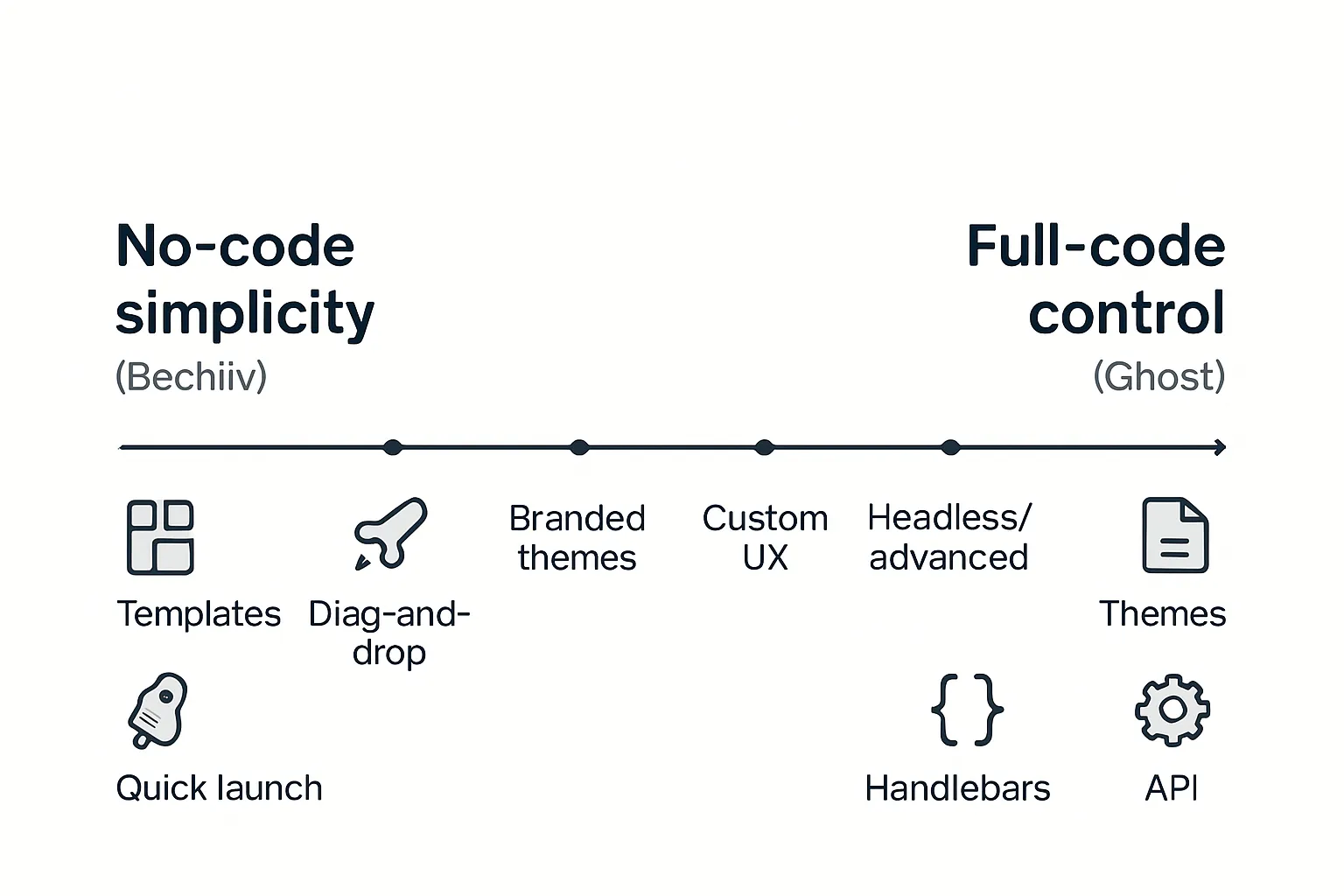
SEO & discoverability
Both support core SEO needs out of the box: sitemaps, canonical URLs, meta fields, and fast rendering. Keep media sizes and script usage in check to preserve Core Web Vitals.
Ghost’s blog‑first architecture favors long‑form content libraries, topic hubs, and evergreen posts - excellent for organic discovery. Beehiiv’s newsletter‑first approach makes every send indexable as a post, which is efficient for archiving and keyword coverage with less setup.
Integrations & APIs
Beehiiv: Native integrations for analytics, commerce, and automation, plus an API to manage subscribers, content, and workflows within a newsletter‑centric stack.
Ghost: An integrations directory, webhooks, and Zapier/Make support. Developers can extend with custom themes, helpers, and APIs - flexible for headless builds or advanced publishing pipelines.
Analytics and automation
Analytics depth
Beehiiv: Newsletter-centric analytics designed for growth teams, including 3D analytics, link heatmaps, and campaign-level breakdowns. UTM support makes it easy to attribute growth across channels, while cohort and source views help you see which acquisition streams drive the most engaged subscribers over time.
Ghost: Member-focused analytics surface who is free vs. paid, what content converts, and engagement trends at the post level. For deeper web analytics, connect Google Analytics or Matomo to unlock funnels, content groupings, and long-tail organic performance. Together, this gives you a clear read on content that acquires and retains members.
Testing & optimization
Beehiiv: Native A/B testing for subject lines and in-email content blocks lets you iterate quickly on hooks, CTAs, and design. Pair with link heatmaps and cohort views to double down on formats that lift CTR and retention.
Ghost: Testing is more manual in core - optimize headlines, hero images, and CTAs using analytics comparisons or via external tools (e.g., GA experiments). For email, use controlled send cohorts and consistent variables to isolate what actually moves engagement.
Automation options
Beehiiv: Build native sequences and workflows for onboarding, education, and segmentation. Trigger drips from tags, signup sources, or poll responses, then route readers to the most relevant content paths automatically.
Ghost: Use Zapier/Make, webhooks, and member events (signup, upgrade, churn) to trigger lifecycle emails and cross-tool automations. Combine with your analytics platform to orchestrate re-engagement, win-backs, and paywall conversion nudges tied to content behavior.
Migration, support, privacy, and reliability
Migration paths
Beehiiv → Ghost or Ghost → Beehiiv: Both platforms support CSV imports/exports for subscribers and content exports. Preserve members and payments by aligning Stripe connections and mapping member states (free/paid) during import.
Ghost Concierge migration service: For a white‑glove move, Ghost can handle end‑to‑end data transfer, including posts, members, and subscriptions, minimizing downtime and preserving continuity.
"Ghost’s Concierge service can migrate you from Beehiiv, including content, members/subscribers, and subscriptions/payments." - Source
Support & reliability
Documentation and community resources on both platforms help with setup and troubleshooting. Higher tiers often include priority support, faster response times, and onboarding help.
Uptime and SLAs: Expect higher SLAs and incident transparency at upper tiers. Review status pages and historical uptime to evaluate reliability.
Security & compliance
Security: Use 2FA and, where available, SSO for admin accounts. Enforce least‑privilege access for team roles.
Compliance & privacy: Ensure GDPR/CCPA data handling, portable exports, clear unsubscribe management, and anti‑abuse protections. Maintain suppression lists and audit API access to safeguard member data.
Final verdict: Which one should you choose? (+ a smart third option)
Choose Beehiiv if
Newsletter growth is priority #1 and you want built‑in referrals/boosts/ad marketplace
You value “just works” simplicity over deep site customization
Choose Ghost if
You’re building a serious publication with a full CMS, themes, and memberships
You want long‑term independence, extensibility, and advanced SEO/site control
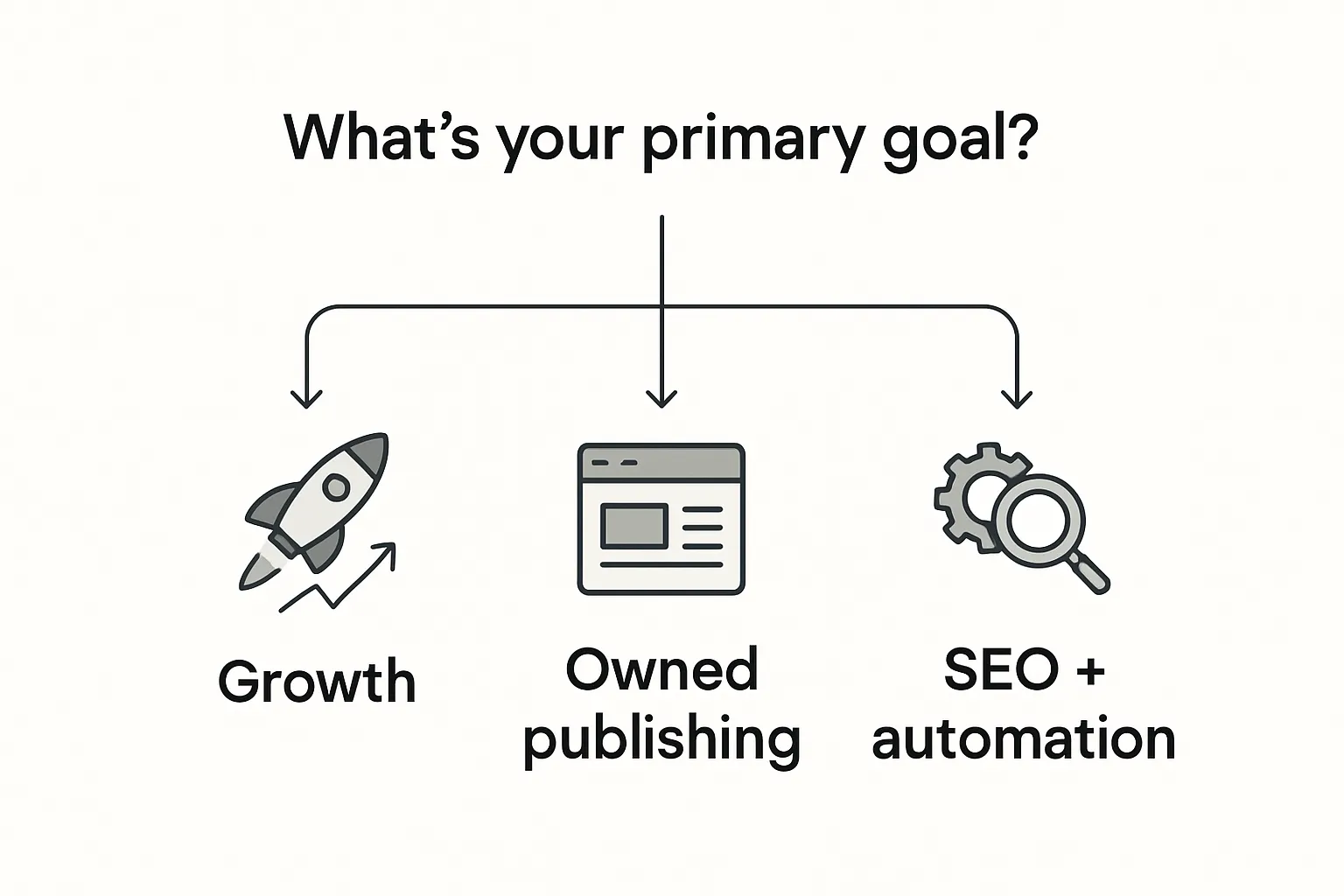
A pragmatic decision guide
Your main channel is email and sponsorships: Beehiiv
Your main asset is your website + content library + members: Ghost
Hybrid? Start where you’ll ship most consistently; revisit at 10–25k subs
Considering an alternative: BlogBowl
If you want an all‑in‑one blog + newsletter stack with heavy AI automation for daily SEO content, internal linking, and media embeds - with fast, SEO‑optimized templates and built‑in analytics - BlogBowl is a strong third option.
Ideal for SaaS/startups that want organic traffic growth on autopilot while still emailing subscribers from the same hub.
Next steps
Validate needs with a 2‑week pilot on either platform
Map migration/export paths early to avoid lock‑in
Reassess at key milestones (first 1k, 10k, and 25k subscribers)


